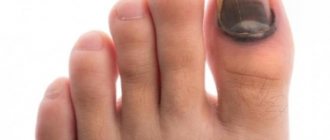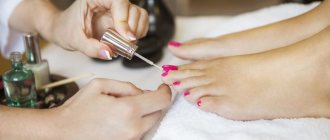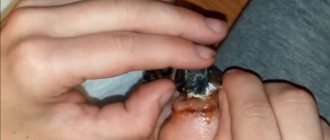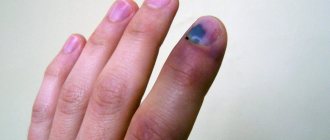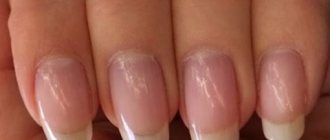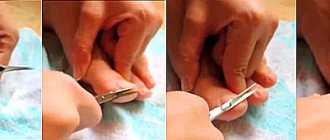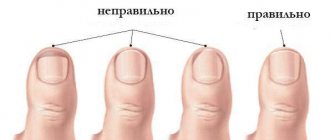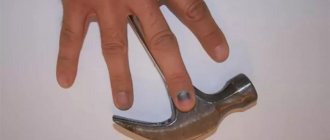The appearance of a black area and spots on the nails of the hands and toes: causes
Such a phenomenon as a black spot, which can appear under a transparent nail plate, is a fairly common occurrence. Moreover, almost every person with different hygiene habits and lifestyle can encounter it at least once in their life.
The reasons for this can be various cases: illness, injury. Such a spot can appear on both the fingers and toes. Of course, most often, this is how the fungus manifests itself, but you shouldn’t make hasty conclusions, because it can also appear in completely healthy people who have no complaints.
There are four main reasons that contribute to the appearance of an unpleasant stain on the nail:
- Presence of any fungus (disease)
- Predisposition or increased pigmentation
- Trauma to a finger or nail plate, resulting in a hematoma
- Liver problems and diseases in humans
Each individual case should be considered:
- Hematomas. This is probably the most common cause of stains on the nail. A hematoma is a bruise, simply put. At the site of the impact, blood accumulates, which is located in the soft tissues; it darkens over time and appears under the nail plate itself. This is easy to understand if you know how the nail itself is built. After all, under the plate itself there is quite soft tissue - the nail bed. These two tissues (skin and nail) are very closely related to each other. Upon impact, the capillary network of soft tissue is damaged. The vessels burst and hemorrhage occurs in the tissue. Such a spot does not have clear boundaries and its size depends only on the force of the impact. The blood darkens, acquiring a bluish, purple and black tint. Such a stain can disappear over time. It is often quite painful and produces unpleasant sensations when pressed.
- Increased pigmentation. This is not a common predisposition, but it does occur in some people. The reasons for this tendency to stains can be the consumption of poor quality water and food, direct ultraviolet rays, and even regular human work in harmful conditions. A characteristic feature of this predisposition is the periodic appearance and disappearance of dots. This happens because the blood pigment changes regularly. There is absolutely nothing scary about this, so you shouldn’t scare yourself about it. It is necessary to adjust your diet and lead a healthy lifestyle.
You should pay attention to such points only if they appear very often, do not disappear and have a very large-scale localization, that is, there are a lot of them. Such points may well have an oncological basis and be a symptom of cancer. If you have such concerns, consult your doctor for advice.
suspicious black dots on the nails may indicate the presence of cancer in the human body
- Liver problems and diseases. Such darkening of the nail plate can often indicate liver dysfunction. This happens because the organ ceases to cope with its duties, that is, it cannot cope with the processing of toxins. This is why dark and black spots appear on the nail plate in places. As a rule, such spots are usually blurry and do not have clear boundaries and sizes. They may appear and disappear periodically. In this case, you should seek help from a therapist who will prescribe tests for you. In no case should you postpone a visit to the doctor if, in addition to spots, you also notice pain in the liver area
- Fungus. The fungus often affects the nail plate of both the hands and feet. In this case, the nail can not only have black spots, but also completely change the color of its plate and become yellow, orange and even brown. Another characteristic sign of fungus is thickening of the nail plate and the appearance of unusual vertical stripes on the nail. It is important to know that after the nail is damaged, the soft tissues also begin to suffer. In this case, treatment should be started immediately as quickly as possible. Before choosing a medicine, consult a dermatologist if possible. He can order you an important series of tests, the results of which will determine your problems and help you choose effective treatment.
Thus, two main reasons can be distinguished for the appearance of black spots on the nail - external (impacts and tissue damage) and internal (diseases of organs and tissues).
black spots on the nail plate, on the toe
Blackened nails on the big toes and on the hands of men and women, reasons
The most common cause of a blackened nail is hemorrhage under the nail plate, which occurs as a result of a finger injury.
The most common injury is the big toe. It is quite active and differs from others in its size. In this case, if there is a bruise and hemorrhage, pain may be observed over the next two weeks when walking, putting on shoes, or pressing on a finger. Pain may accompany the finger until the damaged nerve endings reach complete death.
Pay attention to the nail after two weeks. If the pain does not go away, and the finger has increased in size (swelling), you should immediately consult a doctor.
The cause of blackening of a large nail (like any other) can be microsis. Microsis is a disease that is easy to catch in public places where you have bare hands contact with the floor, handrails, and benches. For example: bathhouse, sauna, public shower, toilet, locker room, and so on. In such places, a person with a disease leaves it on the surface, where it is picked up by a healthy person. Unfortunately, it is almost impossible to cure microsis on your own, because in order to determine the cause of the fungus, you need to undergo many tests.
Myrosis of the nail plate on the big toe
Other reasons for changes in the color of the nail plate:
- A black nail that has a slightly greenish tint is often a symptom of an abnormal and unhealthy gastrointestinal tract.
- A black nail with a slight bluish tint indicates that a person has problems with blood circulation
- A black nail with brown and burgundy shades may indicate disorders of the central nervous system and problems with the brain.
Another common cause of blackened nails on both the fingers and toes is hemangioma.
Hemangioma is a disease that causes the growth and subsequent darkening of blood vessels in the soft tissues under the nail plate. In addition, it causes unbearable and very noticeable pain. In some cases, it appears even before the nail turns black. Hemangioma is a kind of tumor under the nail, which can also be felt by pressing. If the dark color of the nail plate turns white, this is a clear symptom of the presence of a neoplasm.
nail hemangioma: A - dark stripe, B - dark spot
Pay attention to how you feel. If, in addition to pain, you regularly feel discomfort, this is a signal that there is strong pressure under the nail. In such situations, you cannot do without the help of doctors. The doctor will recommend removing the nail plate and only then performing a series of treatment procedures. If the nail is removed, you can perform all the necessary manipulations, get rid of the tumor and eliminate the pain. As a result, the dead nail is replaced by a new healthy one.
Not only drug treatment, but also a healthy diet, as well as regular salt baths will help speed up the healing process.
External factors
Among the external reasons that make a nail black, there are two:
- Mechanical damage.
- External painting.
Blackening of the nail
In the first case, there is no need to worry, the change in the color of the nail is the result of hemorrhage after injury and does not cause harm to health. Often the normal color of the nail returns. Sometimes the cause of hemorrhage is simply wearing tight shoes; the owner will not feel when the vessels have burst, the toenail has turned blue or blackened.
It is easy to determine that the cause of a black nail is injury - a local change in the color of the nail plate, blurred edges are observed. More often, at first the nail appears to turn blue, then gradually turns black. With a mechanical injury, the spot decreases and the toenail moves away from the bed. Of course, the process is not very pleasant, but if you have patience, everything will be restored.
The second external reason is rare. Some substances, interacting with the nail plate, cause discoloration that is difficult to eliminate. An example is contact with potassium permanganate. If the nail turns blue or blackened from potassium permanganate, do not worry.
A common reason for external staining is the use of low-quality varnishes applied to the nail without prior treatment with a special base. The varnishes contain aggressive components that penetrate the nail plate and cannot be removed by nail polish remover. Growing the nail completely will eliminate the problem.
Nail polish
Why did tight shoes turn my toe black?
If the nail turns black not from internal reasons, that is, problems with the health of internal organs, then from external ones. The nail can also turn black due to impaired blood circulation. This can happen when a person wears shoes that are too tight or uncomfortable. As a result, the finger is slightly injured and turns blue due to hemorrhage.
After the cyanosis goes away, the blood coagulates and it is for this reason that blackness appears under the nails. If the resulting hematoma is not too large in size, then it does not require any intervention and can resolve on its own over time. If the spot is large enough and occupies the entire nail plate, this means that blood circulation in the damaged vessels on the finger is completely disrupted.
Most often, this process ends with the rejection of the broken, damaged nail. After the diseased nail is rejected, a whole healthy plate should grow back.
black nail due to wearing tight shoes
To alleviate your condition and allow the nail to recover, you need to provide comfort to your finger. Avoid shoes that are too narrow and uncomfortable. Shoes should not be narrow, not tight, and should not rub. It is advisable that shoes be made from natural and high-quality materials.
You should also be careful about your lifestyle: avoid traumatic situations, do not engage in active sports during the healing period of the finger, eat healthy food that contains a sufficient amount of calcium.
Why does the nail turn black in diabetes?
Diabetes mellitus is a disease that can affect the integrity and health of nails, both on the hands and feet. Why is this happening? Most often, the plates on the lower extremities are damaged due to the fact that blood circulation in the body and in the legs, in particular, is impaired. This can also happen when infected with a fungus. The fungus, which can be present on the nails of a healthy person for any reason, does not spread as quickly as on the nails of a person with any form of diabetes. Also, microbes, which are the main causes of fungal disease, can very actively spread throughout the entire foot of a diabetic and to soft tissues in particular.
It is not difficult to recognize and distinguish the fungus - the nail plate not only changes its color and turns black, the nail becomes thicker and denser. Often it starts to flake.
The fungus often affects the nails of people with diabetes because their metabolism is impaired. Diabetics are also distinguished by the fact that, along with the fluid, their sweat glands secrete glucose, which is very favorable for the development of fungus.
how diabetes can affect diseases associated with blackening of the nail plates
Another problem for people with diabetes is frequent ingrowth of nail plates into soft skin tissue. Such a nuisance occurs for the same reason - impaired circulation in the body and outflow of blood in the legs. Inconvenient, non-compliant shoes significantly aggravate the situation, allowing this process to happen faster. As a result, the finger swells, turns red and a hematoma forms.
In this case, you should definitely seek help from a doctor. If ignored and left untreated, the ingrown toenail will cause soft tissue infection and allow the toe to fester. In the worst case scenario, the plate or even the affected finger will need to be removed. This phenomenon is called “diabetic foot” syndrome.
Onychomycosis: mycotic nature of changes
Penetration of the fungus into the nail bed area causes the growth of its colonies, which disfigure the protective layer of the finger and always change its shade. A common clinical picture: the patient sees yellow or brown spots on the nails, which become more loose (often break and peel off). The causative agent is the fungus Candida albicans.
When black spots suddenly appear on the toenails, a person thinks they have suffered an injury. The absence of rough influence is a reason to suspect infection with a moldy fungus, which initially causes the appearance of a dark streak. Gradually, it covers a large area, filling the entire keratinized layer of the toe (then similar processes develop on the neighboring phalanges).
Additional signs of onychomycosis:
- thickening;
- bad smell;
- increased fragility;
- inflammation of the cushion;
- cuticle separation;
- soreness.
After the toenail has darkened, the patient observes a systematic degradation of its usual shape. A long course of mycosis leads to the fact that the toenail turns black - although previously it had a yellow or chocolate tint - and peels off very quickly.
A similar process develops when the matrix (root) is affected after the penetration of dangerous microflora onto more than 2/3 of the surface. To eliminate brown spots, sometimes it is necessary to remove them on the nails of the big toes. The opened bed is easier to treat with an antiseptic.
! Mycosis of the feet increases the risk of contracting onychomycosis.
An ingrown toenail is a traumatic change
The medical name is onychocryptosis, which occurs due to the ingrowth of the edge of the plate into the soft skin ridge, which is located on the sides of the finger. Due to strong compression, a subcutaneous hematoma appears, so a person soon discovers that the nails on the big toes have darkened (usually on its edge, where the pathological process begins).
If the painful phenomenon is combined with a condition where there are yellow or brown spots on the patient’s nails, then the attachment of a fungus is suspected. Along with inflammation of the tissue of the feet, pus is sometimes released, which develops due to damage to the dermis and the penetration of pathogenic microflora into them.
Onycholysis - gradual separation
The white space that forms at the end of the stratum corneum gradually increases in size. If the nails in the lower part of the layer on the big toes have darkened, then doctors name 2 reasons - dirt particles getting into the voids and the appearance of inflammation. The symptom is often detected in those who garden.
Causes of the condition:
- onychomycosis;
- limb injury;
- contact with chemicals;
- long-term use of antibiotics;
- systemic mycotic infection.
The bed has brown spots under the horny surface, but the shade can be any color. A non-fungal cause of the lesion does not lead to such a transformation.
Why did the nail turn black after being hit on the arm and leg or if it was pinched?
Household nail injury is a common problem. This can easily happen to both fingers and toes. Toes most often suffer from impacts with furniture, and fingers can be pinched in doorways, windows, or simply hit with a heavy object.
Most often, the first pain from such an injury is very strong and sometimes unbearable. It is sharp, bursting and can even put a person in a state of shock. The pain occurs because the blood vessels of the soft tissues burst and hemorrhage occurs directly under the plate, the blood coagulates and turns black.
Such an injury should not be ignored, but should be treated immediately to reduce the hematoma and reduce pain.
How to reduce pain when a finger is injured and reduce a hematoma:
- First of all, quickly applying cold to it will help to weaken the hematoma in the first couple of days: ice, a cold bottle, dipping in cold water, snow
- You should keep an injured finger in the cold for no longer than fifteen minutes, so as not to make it worse
- This application of cold will constrict the blood vessels and thereby reduce hemorrhage, as well as at the same time reduce pain
A severe hematoma under the nail plate with profuse bleeding can burst the nail from below, lifting it. This rejection of the nail plate is quite painful. Only a surgeon can help in such a situation, who, using a sterile instrument, makes a hole in the nail and releases blood through it before it has a chance to clot.
This surgical intervention will help to avoid the death of the nail; in no case should such manipulation be done using improvised means or on your own in order to avoid unpleasant consequences and blood poisoning.
finger injury, blackened nail
Why does my toenail turn black and hurt?
A sore toenail or fingernail has several causes:
- Traumatic nature. Depending on the bruise, you should choose the right effective treatment to get rid of unpleasant symptoms and eliminate pain
- Fungal nature - requires mandatory treatment with antifungal and antiseptic agents
- As a consequence of disruption of the internal organs, a full examination should be carried out to determine the presence of problems and diseases in the body
If the blackness of the nail is accompanied by unpleasant pain, this indicates that the integrity of the soft tissues has been compromised. In such cases, it is impossible to do without the intervention of doctors. If you do not intervene, the situation may worsen and lead to tissue suppuration.
the nail hurts, problems with nails due to bruises and fungus
Why does the nail turn black?
Let's look at the reasons why the toenail turns black. This happens due to disruption of the capillaries under the plate. Initially, the surface becomes blue, when blood clotting occurs, the nail becomes black. It can turn black completely or in patches.
Black nail
When a small area darkens, it is not necessary to treat; the hematoma will disappear after a while. If the nail plate turns completely black, the result will be rejection of the nail plate.
Nails turn black upon contact with selected chemical elements. In the presence of liver disease, the nails change to black. Due to impaired functioning of the kidneys and liver, disruptions in metabolic processes occur, causing changes in the amount of melanin in the nail plate.
Darkening of the nails in the form of longitudinal stripes means the development in the body of a complex and difficult to treat disease - melanoma, which is an oncological disease. A malignant tumor forms in most cases in the nail bed area. A common cause of discoloration of toenails is a fungal infection that requires mandatory treatment. When wearing narrow, tight shoes, the maximum load falls on the big toe, causing the nail to turn black. In situations where strong pressure is applied to the finger, the nail on the lower extremities can turn black a few days after the injury.
Treatment rarely requires surgery. To eliminate swelling after injury, the nail and skin near the plate on the legs are treated with iodine and a mesh is applied.
Why does my toenail turn black and come away from my finger?
If you have a finger ear injury, it is quite possible to expect hemorrhage due to rupture of blood vessels. This blood enters the soft tissue, where it coagulates and forms a dark spot. Often the bruise is so severe that it provokes the appearance of a tumor.
This tumor bursts the nail plate and causes it to rise, while “giving” the person very unpleasant painful sensations. The finger tries to tear off the affected nail, which by this time may become rough and flake. It should not be pulled out under any circumstances.
The nail that grows over time should be carefully cut off with nail scissors, avoiding pain. Over time, the damaged nail will be replaced by a whole new layer and the finger will recover; this is a completely natural process.
nail plate rejection
Treatment of melanoma
If the blackening of the nail is accompanied by significant pain, a competent and quick diagnosis is required. In some cases, it is possible to develop cancer - melanoma.
Melanoma of the nail plate
Treatment consists of removing the nail plate and part of the affected tissue. Excision of fatty tissue and a section of muscle is performed. The nail plate is completely removed; in advanced stages, the phalanx on the finger is removed.
Why does the nail turn black and not hurt?
Quite often it happens that the fingernail turns black, but does not give the person any painful sensations. Most often, this phenomenon is observed on the big toes of the lower extremities. And it often happens that people simply ignore this problem: men wear closed shoes, and women cover them with a layer of varnish. But this is far from a way out of the situation.
Several factors can affect the darkening of the nail:
- External influence: uncomfortable shoes, mechanical damage, trauma or bruise
- Internal effects: fungal infection, the presence of a benign tumor, disruption of the functioning of internal organs
If the nail turns black as a result of an injury, it’s not a big deal. As a rule, such a bruise does not cause any harm to the body. If the nail turns black as a result of a serious illness, you cannot do without the help of doctors.
Treatment of spots
Spots on toenails need to be eliminated based on the cause of the pathology:
- If the toenail turns black as a result of a mechanical injury, then the patient must be given rest. It is imperative to visit a traumatologist to check your finger for a fracture. During the rehabilitation period, the patient should wear only loose shoes. To prevent infection from penetrating, the damaged area is bandaged. Periodically, the lesion is treated with antibacterial drugs.
- Brown spots that appear on the nails as a result of brain pathologies and disorders of the central nervous system first of all require diagnosis. After the results of the magnetic resonance imaging, the doctor prescribes treatment.
- The nail on the big toe may turn black as a result of a neoplasm that originated under the plate. If you experience discomfort when walking, you should visit an oncologist as soon as possible to remove the tumor.
- Blackening of the big toes with diabetes mellitus appears as a result of poor circulation or slow metabolism. To eliminate the pathological process, consultation with a specialist is required.
- If the nail on the lower limb has darkened as a result of wearing tight shoes, then simply change the shoes to more comfortable ones.
Traditional methods of treatment
To remove stains, use baths with herbal decoctions, tea tree oil and essential oils. Before the procedure begins, the lower limbs are steamed in warm water for 10 minutes.
- Iodine is one of the most effective methods for treating black spots. The affected area is treated with an alcohol solution of iodine 2 times a day. The therapeutic course lasts until complete rehabilitation.
- Ground horseradish is good at eliminating fungal infections. The crop is grated using a fine-toothed grater, then the mass is placed on the affected area and covered with a band-aid. The compress is applied before going to bed. Repeat the procedure twice a week until complete recovery.
- Baths with salt not only get rid of infections, but also have a healing effect on the skin of the feet. Take a liter of water and pour three tablespoons of soda and one of salt into it. The limbs are kept in such water for 20 minutes. Then a bandage moistened with celandine juice is applied to the affected area. The bandage is kept in place for no more than 30 minutes. The measures are repeated until the plate is completely restored.
Therapy with traditional methods is agreed upon with the attending physician.
What to do if the toenail turns black, how to treat it?
Most often, after an injury, the fingernail or toenail turns black. It is not always possible to see a doctor on time. For this reason, you should definitely know the therapy that you can do for yourself:
- If your finger is injured, give it rest, stop moving it or walking if it is on your leg
- Raise your leg above your head to ensure normal blood circulation
- Until the finger gets rid of blackness and pain, you should provide it with loose shoes
- Apply a soft bandage to your finger to protect it from repeated injury. Use a bandage or adhesive tape
- Try not to handle the affected finger, especially if your household activities involve water or chemicals (wear gloves)
- Immediately after you receive a bruise, it is recommended to treat the nail and apply ricinol emulsion to it, which can stop bleeding and slow down the inflammatory process, accelerating the regeneration of soft tissues
- A few days after the injury, choose an anti-inflammatory ointment for your nail and finger for faster healing (arnica or heparin ointment). The medicine should be applied three times a day
- In order to relieve swelling of the finger and eliminate severe pain, you should apply a compress with dimexide to the bruised nail and finger. The compress should be done daily, preferably before bed, leaving the soaked gauze on the sore spot for at least half an hour
The most common thing - badyaga - will help you cope with the blackness under the nail and eliminate the pain. You can buy it at a pharmacy for a reasonable price. It is sold in powder form, which is diluted with water. The resulting mass is applied to the sore spot. If you do not have the opportunity to see a doctor, regularly lubricate the nail with bodyagu and gradually cut off the affected nail with scissors as it grows back.
You should understand that you should never tear off your nail - this can disrupt the natural rejection process and lead to infection. Tearing off part of the nail prevents the renewal of the entire nail plate.
Pay attention to how your finger perceives the treatment. If the inflammation does not decrease, but on the contrary becomes larger, the finger and the area around the nail turns red - the situation may worsen. It is quite possible to get purulent inflammation. In this case, you should stop any treatment and seek help from a specialist in the hospital.
What to do if your nail turns black
If your nail has turned black, you first need to determine the cause. Timely and correct diagnosis will help to avoid complications and quickly get rid of this aesthetic problem.
In case of injury
If your skin turns blue and your nail turns black when your foot hits a hard object, this is a sign of a fairly serious injury. Therefore, it is better not to self-medicate and go to the nearest emergency room. But immediately after the blow, you should give yourself first aid to reduce unpleasant consequences:
- Apply ice to the bruise or soak the injured area in cold water. This will help avoid or at least reduce the risk of hematoma.
- If there is a wound, it must be treated with a disinfectant or antiseptic to avoid bacteria and infection.
- Try not to step on your injured leg.
- If there is ointment for bruises in the house, use it. It will also help reduce the risk of hematoma.
For fungus
If you suspect a fungus, the first thing you should do is go to your doctor so that he can prescribe an accurate test and give recommendations for treatment. But the recovery process for this disease is very long, and in order not to harm yourself or your household even more, you must take some precautions:
- change your socks often;
- do not walk barefoot;
- do not allow your shoes to be worn or tried on;
- use separate pedicure tools;
- Disinfect the shower cabin, bathtub, or take a shower in rubber slippers after yourself;
- Make sure your feet are always dry and not sweaty.
For diseases
Timely diagnosis of the disease will help tidy up not only your nails, but also your health. And it’s better not to delay visiting a doctor, because your well-being may depend on it. And having gotten rid of the root cause, it will be easier to put the nail plate in order.
